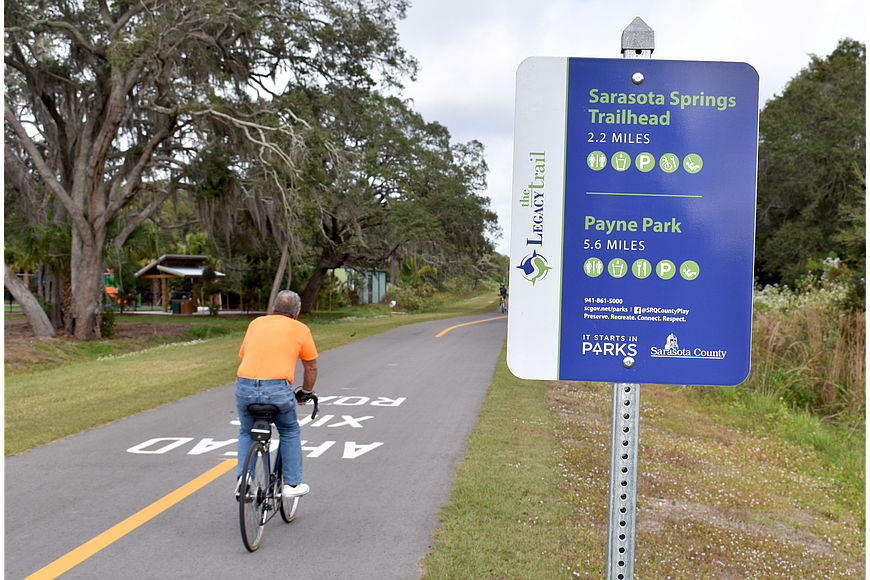- January 11, 2025
-
-
Loading

Loading

Since a 1999 voter-approved referendum established its Environmental Sensitive Lands Protection Program, with a 2005 extension through 2029, Sarasota County has made 90 acquisitions of some 40,000 acres for permanent conservation. In addition, since 2005, the county’s Neighborhood Parkland Program has made 23 acquisitions comprising approximately 116 acres.
The overall program's expiration is only six years away, though, meaning the end of the 0.25 mill funding source for the acquisition and maintenance of the land.
County Commissioner Mike Moran sounded what he called a “fire alarm” during the commission’s first 2024 budget workshop of the fiscal year, held March 22. He told his fellow board members that without a timely referendum, after 2029, revenue for maintenance will have to be pulled from other areas of the budget.
“You can see as we sit today, if you never bought another blade of grass, it's $3 million,” Moran said of the looming maintenance fund balance deficit. “This board needs to have a discussion, and definitely the board after that, that you’d better be careful buying one more blade of grass if you can't maintain it.”
Moran sounded that warning particularly to freshman commissioners Joe Neunder and Mark Smith because, should they be reelected when their terms expire in 2026, they will be the only current commissioners serving at that time. Moran, Nancy Detert and Chairman Ron Cutsinger will reach their term limits in 2024.
“If you're sitting here in (fiscal year 2027 or 2028) you don't have a penny to pay for this maintenance, and (County Administrator) Jonathan (Lewis) is going to ask you where do you want me to cut?” Moran said.
Smith took a moment to look into a future minus the current majority of members on the commission.
“Those of us who may be here longer may be looking at a point in time where this is going to be 50% acquisition and 50% maintenance,” Smith said. “The more access you have to the properties and the more equipment that we put out there, the maintenance is going to keep going up. Also there are going to be fewer opportunities to purchase land as the county keeps getting developed, so we need to have an aggressive approach to purchasing. We won't be purchasing as much in the future just because there won't be the land there, but until we get there, we’d better buy it while it’s there.”
Currently, 15% of the revenue for the Environmental Sensitive Lands Protection and Neighborhood Parkland programs is for maintenance. At $3.03 million in designated revenue and projected maintenance costs of $4.46 million, by the end of the current fiscal year, that’s a one-year deficit of $1.43 million.
Factoring in 8% inflation and expansion expense annually through 2029, the maintenance fund balance deficit swells to nearly $9.2 million if no changes are made. An increase in the maintenance allocation to 20% reduces that deficit to $1.3 million, and a 25% allocation would create a maintenance fund balance surplus of $6.6 million.
Those projections vary by rate of inflation and program expansion.
Shifting the balance to a higher maintenance percentage, though, means less money for acquisition, although short of an approved referendum further acquisitions couldn’t be maintained anyway. The maintenance costs are, in part, a result of commission direction that taxpayer-acquired park land should be made accessible to the taxpayers. That means facilities must be built and maintained.
Staff is recommending a sliding percentage of 20% to 25% of total ESLPP/Neighborhood Parkland Program revenue dedicated to management and maintenance, and evaluating for further need on an annual basis within the normal budget process. Staff also anticipates continued acquisition of land and increased public access and appropriate programming of those lands, plus continued capital development and improvements such as restrooms, picnic areas, kayak launches and other recreation amenities.
“We have seen an increase in cost to manage these lands as well as level of service,” said Nicole Rissler, the county’s director of parks, recreation and natural resources. “We are now cleaning our restrooms seven days a week. We heard loud and clear from our community and our visitors that we needed to increase that level of service in 2017. And it (initially) cost less than $1,000 to remove exotics from one acre. That costs us almost $5,000 today.”
Moran suggested staff should be granted the flexibility to apply whatever percentage of ESLPP and Neighborhood Parkland Program funds necessary to “make the red numbers go away.” That plan will be presented during formal budget hearings this summer. Meanwhile, Lewis told commissioners, staff can begin planning for a referendum to extend the program, and its dedicated funding mechanism, beyond 2029.
"I think 2026 is a really good idea because if you go out to the voters, and let's say it failed, you could go back out again in 2028, which would give you enough buffer time for when the funds stop in 2029,” Moran said.
“It won’t fail in 2026,” Cutsinger predicted. “It’ll pass by 75%.”
This article originally appeared on sister site YourObserver.com.